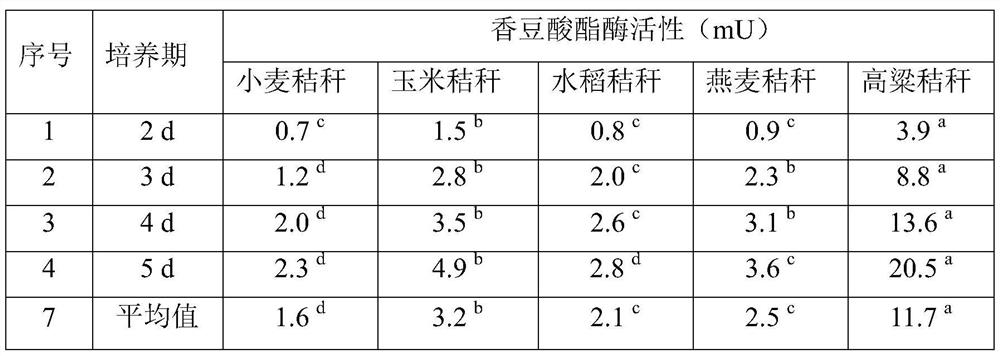Naturally symbiotic mixed culture and method for producing coumaric acid esterase by degrading straws by using naturally symbiotic mixed culture
A mixed culture, coumaric acid ester technology, applied in the directions of microorganism-based methods, biochemical equipment and methods, microorganisms, etc., can solve problems such as the inability to achieve high enzymatic activity of coumaric acid esterase, and prevent bacteria from being affected. Pollution, ease of promotion, and the effect of improving efficiency
- Summary
- Abstract
- Description
- Claims
- Application Information
AI Technical Summary
Problems solved by technology
Method used
Image
Examples
Embodiment 1
[0037] Embodiment 1, strain screening and identification
[0038] 1. Collection of yak rumen juice
[0039] The research site is located in the grazing pasture of Xinghai County, Hainan Tibetan Autonomous Region, Qinghai Province. The annual average temperature is -1-1.3°C, the highest temperature is 26°C, the lowest temperature is -30°C, and the altitude is 3100-4300m. It belongs to the cold plateau climate type with drastic temperature changes. With strong sunshine and abundant rainfall, alpine meadow is the main grassland type. Wild pastures mainly include fescue, Kobresia, Kobresia Tibetan, and Kobresia tenifolia, which are the main dominant species in this area.
[0040] 20 healthy male yaks (age 4-5 years old, body weight 250±50kg) were used as experimental animals in the whole grazing yaks that ate natural forage and did not supplementary feeding. Insert one end of the stainless steel gastric tube into the rumen through the opener, and the other end is connected to an...
Embodiment 2
[0074] Embodiment two, the preparation of the mixed culture YakQH5 bacterial agent of anaerobic fungus (Neocallimastix frontalis) and methanogen (Methanobrevibacter gottschalkii)
[0075] Pipette 1 mL of YakQH5, a mixed culture of anaerobic fungi (Neocallimastix frontalis) and methanogens (Methanobrevibacter gottschalkii), into 9 mL of anaerobic medium with air-dried and crushed wheat straw as a substrate in a Heinz anaerobic tube, and add 0.1 mL of compound Antibiotics (1600IU / mL penicillin and 2000IU / mL streptomycin sulfate), anaerobic culture at 39°C for 72 hours, the growth peak will be reached, and the fermentation broth is a highly active bacterial agent at this time.
Embodiment 3
[0076] Embodiment 3, mixed culture YakQH5 anaerobic fermentation degrades straw to produce coumaric acid esterase
[0077] 45mL of liquid basic medium was placed in a 100mL anaerobic fermentation bottle, and 0.5g of dried and pulverized wheat straw, corn straw, rice straw, oat straw and sorghum straw were used as substrates. Deoxygenated, autoclaved. Draw 5mL of the mixed culture YakQH5 obtained in Example 1 and inoculate them into the above-mentioned anaerobic medium with stalks respectively, and add 0.5mL compound antibiotics (1600IU / mL penicillin and 2000IU / mL streptomycin sulfate) at the same time , 39°C anaerobic culture for 5 days. A total of 3 parallel experiments were set up, and the activity of coumaric acid esterase in the anaerobic bottle was measured every 24 hours.
PUM
 Login to View More
Login to View More Abstract
Description
Claims
Application Information
 Login to View More
Login to View More - R&D
- Intellectual Property
- Life Sciences
- Materials
- Tech Scout
- Unparalleled Data Quality
- Higher Quality Content
- 60% Fewer Hallucinations
Browse by: Latest US Patents, China's latest patents, Technical Efficacy Thesaurus, Application Domain, Technology Topic, Popular Technical Reports.
© 2025 PatSnap. All rights reserved.Legal|Privacy policy|Modern Slavery Act Transparency Statement|Sitemap|About US| Contact US: help@patsnap.com

